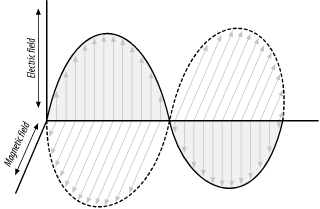7.5 Redundant Links
| All antennas show a characteristic known as polarity, which refers to the direction that the electrical field moves in as it leaves the antenna. Simultaneously, magnetic waves leave the antenna at a 90-degree angle to the electrical waves. Most common antennas show a linear polarity (i.e., vertical or horizontal). Some antennas, like a wound helical antenna, [1] actually demonstrate circular polarity, in which the waves move outward in a spiral, always perpendicular to each other.
In order for one antenna to receive the signals of another, the polarity must match. Omnidirectionals (and most sectors) have vertical polarity. Dishes and yagis can be mounted vertically, horizontally, or somewhere in between. The Pringles can is just a yagi, and its polarity is determined by the position of the antenna connector. A circularly polarized antenna (like the helical) has its polarity determined by the direction of the outer winding: either clockwise or counterclockwise. You can use polarity to your advantage to try to eliminate some noise on a long-distance link. First try each end in vertical polarization and measure the perceived noise. Then rotate each end 90 degrees and measure the noise again. Use the position that shows the least amount of noise, and you should have a more stable link. Figure 7-5 shows typical polarization. Figure 7-5. The polarization of an antenna is determined by the direction of its electrical field; the magnetic field is perpendicular to the electrical field Since an antenna can receive signals only from antennas whose polarity matches its own, you can also use this property to make more efficient redundant links. For example, suppose you wanted to use two radios at either end of a link to provide 22Mbps total bandwidth to a remote location. Usually, you would need to use two channels separated by 25MHz (i.e., 1 and 6, or 2 and 7, or 3 and 8). If you use one antenna with vertical polarization and another with horizontal polarization, and separate the antennas by a few feet, you could use the same channel for all of your traffic. This means less noise in the band for you and your neighbors (and it theoretically gives you up to six possible simultaneous links without interference, where normally only three were possible). As far as IP goes, you can either route the traffic independently or use the channel bonding features of the Linux 2.4 kernel to weld all of your connections into one big pipe. This mode of operations is new, experimental, and left as an exercise to the reader (hey, if you're anything like me, you could stand more exercise in your life). |
EAN: 2147483647
Pages: 111
- Chapter III Two Models of Online Patronage: Why Do Consumers Shop on the Internet?
- Chapter IX Extrinsic Plus Intrinsic Human Factors Influencing the Web Usage
- Chapter XI User Satisfaction with Web Portals: An Empirical Study
- Chapter XII Web Design and E-Commerce
- Chapter XIII Shopping Agent Web Sites: A Comparative Shopping Environment